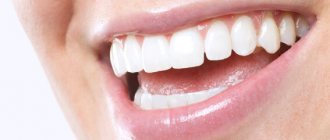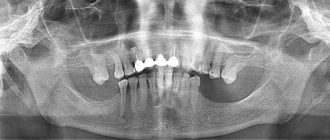Modern solutions offered by clinics allow an individual approach to each patient and selection of the optimal method of restoring teeth in case of their destruction or absence. Prosthetics allows you to restore the aesthetics of the dentition and natural chewing functions, while prolonged absence of teeth always leads to serious health consequences - it affects the bite, jaw joints, and facial appearance. Therefore, it is so important to undergo prosthetics as soon as possible and enjoy the result. But what if instead of “pleasure” you get pain after dental prosthetics?
When is pain after prosthetics normal?
The causes of pain can be different. First of all, we will reassure those who have pain after prosthetics literally on the same day or not the next day that the prosthesis, be it a crown or a bridge, was installed. In 99.9% of cases, this is a normal situation that does not promise anything bad. The anesthesia (if it was used) has stopped working, you are gradually getting used to the new prosthesis, adaptation is required. Discomfort and even a semblance of pain in such conditions is normal. But you still need to carefully monitor your feelings – and consult a specialist if:
- The pain does not go away within 7-10 days
- The pain effect increases
- The pain changes character - from aching it turns into throbbing, it occurs under certain conditions, for example, as a reaction to hot food, or worsens at night when a person takes a horizontal position.
Causes
Unprofessionalism of the doctor
The qualifications and experience of the implantologist play an important role in the success of implantation. If these levels are insufficient, the patient may face a number of problems:
- violation of antiseptic rules during the installation of rods;
- incorrect selection of implant models;
- installation of low quality structures;
- injury or overheating of bone tissue by a drill;
- poor-quality preliminary preparation before surgery with the ensuing consequences.
The choice of dentistry and doctor should be taken seriously. Sometimes patients come to us with complications after unsuccessful implantation in other clinics. It takes a lot of effort to save installed implants, but it is not always possible to stop rejection. In some cases, it is necessary to undergo re-implantation, which is financially costly for the patient. Therefore, it is better to immediately contact experienced professionals who provide a guarantee for their work.
Patient negligence
After implantation, the patient is required to be fully conscious and follow the doctor’s recommendations. Among the most common causes of pain and other complications in the postoperative period:
- neglect of regular oral hygiene;
- failure to appear for preventive examinations with a doctor;
- refusal to take prescribed medications;
- smoking;
- poor nutrition;
- non-compliance with the temperature regime of food (eating too hot or cold foods).
Features of the body
The healing of implants occurs differently in each patient, depending on the tissue’s ability to regenerate, health status and other internal factors. Among the characteristics of the body, the cause of the development of pain syndrome can be:
- weakened immune system;
- allergic reaction to metals;
- exacerbation of chronic diseases, general or dental;
- pathologies of teeth located next to the installed structure;
- increased load on the implant;
- non-acceptance of a foreign body by the jaw tissues.
Peri-implantitis
If dental implants hurt a year after installation, most likely we are talking about peri-implantitis, inflammation of the jaw tissue. Occurs as a result of doctor errors or patient negligence. Manifested by the following symptoms:
- jerking pain;
- itching;
- redness or blueness of the mucous membrane;
- swelling;
- discharge of pus from under the gums when pressed.
If these symptoms appear, you should immediately contact the clinic. If surgical intervention is performed in time and the hole is cleared of purulent masses, the implant can be saved. Failure to consult a doctor in a timely manner may result in removal of the structure. Re-implantation is possible only after complete relief of the source of infection.
Causes of tooth pain under a crown or denture
- If you have not had root canal treatment to remove the pulp before getting a crown, pressure on the damaged nerve may cause pain.
- Patients with malocclusion and bruxism may experience pain at night from pressing on ridges or areas of the tooth that are higher than normal.
- If the denture has shifted, exposing part of the tooth, or, worse, is pressing on the dental nerve, then the slightest pressure or change in temperature can send strong pain signals.
- Teeth under a crown are also at risk for all the problems associated with regular teeth, meaning they can become infected, break, and become vulnerable if the enamel wears down. And this can cause pain.
Methods for fixing a crown
In modern dentistry, a crown is placed in 3 ways
.
Installing a crown on a pin
If the tooth root is not destroyed and is healthy, then a pin is placed inside. It is easy to install; before installation, the doctor gives an injection with an anesthetic.
The pin is placed in the tooth socket and secured with special solid compounds.
A crown prosthesis is installed on the pin itself.
It is also possible to restore a tooth without a pin using CEREC technology.
Fixing the prosthesis using a tab
A stump inlay is a cast stump of a tooth with a root part.
When installing a crown, the same method is used as when installing a pin. The dentist makes a hole in the tooth, and the root part of the inlay is placed into it. Next, a crown is put on it, just like, for example, on a living tooth ground before the procedure.
Implant supported crowns
A fixed prosthesis lasts much longer than a removable one; it is more reliable and durable. To install such a prosthesis, you need the strongest possible fixation on the patient’s tooth.
It is not always possible to save the root of a tooth; in order to install a crown on an implant, the tooth is removed.
An implant is installed in place of the removed unit. The implant material can be different, it all depends on the budget. It can be titanium or ceramic (zirconium).
Outwardly it resembles a small bolt that needs to be screwed into place of the removed tooth root.
The third installation option is the longest and most expensive, but the patient actually receives a new tooth that will not be susceptible to caries, destruction and will not hurt.
Preparation before installing a crown
In order for the crown to fit tightly to the tooth, it must be ground. The procedure is quite painful, so the doctor will use an anesthetic.
The degree of turning depends on the thickness of the crown, as well as what material is chosen.
In most cases, the nerve of the tooth is removed because it can be burned during the grinding process.
Removal of the nerve involves cleaning the canals and their sanitation. If the removal of pulp or the cleaning of the canals was of poor quality, then pain may appear under the crown.
A tooth under a crown can hurt for various reasons. We will talk about them further in the sections of the article.
After grinding, an impression is taken from the tooth, and a plaster model is made from it in a special laboratory. The prosthesis is cast along it.
While the prosthesis is being made, the patient is given a temporary onlay for the tooth. After all, during the period of turning it becomes more sensitive. The temporary structure is made of plastic and placed on temporary cement.
When installing a permanent implant, the old structure is removed, the remaining cement is cleaned off and a new crown is secured.
This is called fitting it in, only if the patient does not complain of pain in the tooth under the crown, the gums do not hurt, and nothing interferes, then the structure is placed on an already strong, durable composition.
There is no way to remove it. To remove such a crown, the tooth will have to be sawed into two parts.
When should the crown be removed?
You should not carry out this procedure yourself; it should be done by an experienced dentist.
The crown is removed if there is deformation, chips, or cracks.
When the service life has already expired.
If there is pain under the crown, it gets worse from time to time.
What to do if a tooth hurts under a denture?
If toothache occurs after dentures, the first priority is to identify the cause as soon as possible and apply appropriate therapeutic measures. This problem will not resolve on its own, and any home remedies will not be effective. Therefore, do not wait and contact your dentist for professional help.
If the dentist discovers a tooth infection under the crown, he or she may recommend root canal treatment, which usually requires removal of the denture. In some cases, a hole can be drilled into the crown, allowing the dentist to access the root canal without having to remove and install another crown. This is a complex operation, but it will save you money since the removed crowns are often no longer reusable.
Types of complications of dental prosthetics
Prosthetic stomatitis
The most common complications of dentures are:
- Cementation of fixed structures after their fixation;
- Allergic reactions to materials used during prosthetics - most often residual monomer in the base of a removable denture;
- Denture stomatitis is a various pathology of the oral mucosa of an inflammatory nature, caused by the presence of a denture in the oral cavity;
- Caries and its complications under structures;
- Galvanic syndrome is a pathological condition, the appearance of which is caused by the effect of galvanic currents on the tissues of the oral cavity;
- Discomfort caused by the installation of prostheses - rubbing, formation of bedsores under the prosthetic bed.
Prevention of pain after dental prosthetics
As with all dental procedures, the simplest and cheapest solution is to prevent the problem from occurring in the first place.
- If you have dental crowns or bridges, you should have a dental checkup at least once every 6 months. The dentist will monitor the condition of the teeth under the dentures, since they are initially at risk.
- Hardware cleaning of bacterial plaque and possible food debris will prevent the development of infections and caries; this procedure is mandatory along with normal home oral hygiene, including brushing teeth and using dental floss.
- It is also important to monitor the integrity of the dentures - avoid hard foods and excessive loads so that the denture is not damaged or its tight fit to the stump of the supporting tooth is broken.
Don’t endure pain after dentures - contact the orthopedists at the ILATAN family dentistry closest to your home to get advice and help. Registration is available by phone +7 (495) 748-50-50.
Causes of discomfort after prosthetics
- Error in the choice of design or incorrect installation.
A denture that fits too tightly can cause bedsores. If the structure is not secured correctly, then food can accumulate between the gum and the denture, resulting in inflammation, pain and an unpleasant odor.
- Lack of hygiene. Due to poor oral care and denture care, caries and gum disease can occur.
- Allergy
to prosthetic materials. - Loosening of the prosthesis
due to long use
.
In this case, the chewing load is distributed incorrectly, so discomfort may occur.
Complications of dentures. Galvanic syndrome.
The physical concept of galvanism can also occur in the oral cavity in the form of the syndrome of the same name. This is the formation of a galvanic electric current in the oral cavity in the presence of dissimilar metals in the patient’s mouth, with correspondingly different potentials. In this case, all the conditions necessary for the formation of galvanic current arise. In such situations, saliva performs the function of an electrolyte.
Clinical manifestations are as follows:
- The appearance of a metallic taste in the mouth;
- Darkening of metal parts of prostheses;
- Headache;
- Allergic reactions.
This situation can be resolved by replacing dentures .
Allergy to dentures
Another complication may be the development of an allergic reaction. Various materials from which dentures are made can cause denture allergies in patients at risk. To avoid this complication, specialists at INTAN implantation and dentistry centers collect a detailed patient history and, if necessary, perform allergy compatibility tests.
There are cases when an allergy to dentures occurs despite careful selection of the material. The speed of development of an allergic reaction can vary: from several hours to several days after installation of the prosthesis. If you experience symptoms such as rashes or inflammation in the oral cavity, a burning sensation on the tongue, or dry mouth, immediately contact the specialist who installed the denture for you.
Prosthetic stomatitis as a complication of dental prosthetics
Denture stomatitis
Denture stomatitis is an inflammatory lesion of the oral mucosa under the denture, accompanied by redness, pain, the appearance of erosions and ulcers, and difficult or impossible eating. Stomatitis can be catarrhal, erosive, ulcerative, ulcerative-necrotic, hyperplastic. The main reason for the occurrence is the discrepancy between the shape and size of the base, clasps of the prosthesis and the border and surface of the prosthetic bed, as well as in violation of the articulation of the dental arches of the jaws.
To eliminate the manifestations of prosthetic stomatitis, the patient must contact a dentist to correct the structure and carry out treatment using antiseptic solutions, ointments and gels.
Dental prosthetics complicated by allergies
Allergic reactions to dental materials are quite common. The main symptoms of this pathology are:
- Redness and swelling of the mucous membrane;
- Inflammation of the salivary glands;
- Dryness and burning in the mouth.
The first signs of an allergic reaction appear within a fairly short time after installation of the prosthesis, most often in the first few hours. In some cases, 2-3 days after completion of prosthetics. If any symptoms are detected, you must consult a doctor with a request to eliminate the pathological process. In some cases, the structure will be made of colorless plastic .










